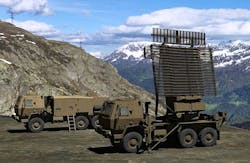Lockheed Martin to provide Air Force with long-range solid-state gap-filler radar systems
HANSCOM AIR FORCE BASE, Mass. 14 Oct. 2016. U.S. Air Force air-surveillance experts are asking Lockheed Martin Corp. to build and install a long-range gap-filler radar system for the nation of Jordan.
Officials of the Air Force Life Cycle Management Center at Hanscom Air Force Base announced a potential $41.7 million contract Thursday to the Lockheed Martin Rotary and Mission Systems segment in Syracuse, N.Y., for gap-filler radar in Jordan.
Gap-filler radar supplements the coverage of the principal air-defense, air surveillance, and air-traffic-control radar systems in areas where coverage is inadequate.
Lockheed Martin will provide two long-range radars, and three upgrades to existing long-range radars, and integrate new and upgraded radar into the overall command, control and communications system, Air Force officials say.
Lockheed Martin relies primarily on the company's TPS-77 multi-role radar system for gap-filler applications. The Lockheed Martin TPS-77 long-range transportable radar has radar signal-processing algorithms that optimize the system to detect low-flying aircraft near wind turbine farms, which are notorious for creating radar clutter.
Related: Air Force awards Lockheed Martin $14.7 million radar contract
The AN/TPS-77 is an L-band, phased array, all-solid-state radar with a planar array antenna that rotates to provide 360 degree azimuth coverage. As the antenna rotates, the radar transmits pencil beams that are electronically phase scanned to provide elevation coverage.
The 3-D radar can provide data on targets at ranges as far away as 250 nautical miles and elevations as high as 100,000 feet. Instead of using one transmitter, the AN/TPS-77 uses 34 all solid-state transmitters and receivers that are located on the antenna array.
This architecture eliminates high power rotary joints and central transmitters -- two common single points of failure in most long-range radars, Lockheed Martin officials say.
On this contract Lockheed Martin should be finished with the work by April 2018. For more information contact Lockheed Martin Rotary and Mission Systems online at www.lockheedmartin.com/us/rms.html, or the Air Force Life Cycle Management Center at www.wpafb.af.mil/aflcmc.
Learn more: search the Aerospace & Defense Buyer's Guide for companies, new products, press releases, and videos

John Keller | Editor
John Keller is editor-in-chief of Military & Aerospace Electronics magazine, which provides extensive coverage and analysis of enabling electronic and optoelectronic technologies in military, space, and commercial aviation applications. A member of the Military & Aerospace Electronics staff since the magazine's founding in 1989, Mr. Keller took over as chief editor in 1995.

